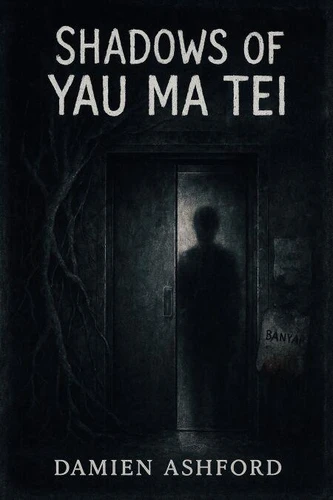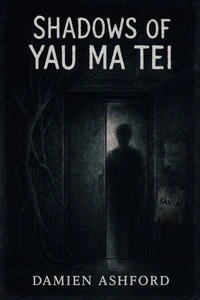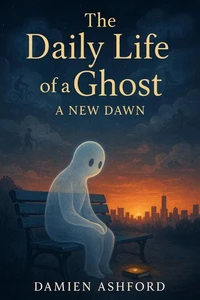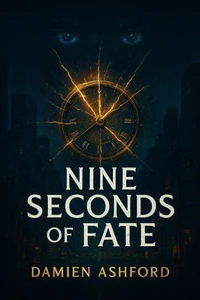- Accueil /
- Damien Ashford
Damien Ashford

Dernière sortie
Shadows of Yau Ma Tei
Ah Kin is a chronicler of light, a man who measures Block 12 the way others count breaths. One damp evening he develops a brittle, charred negative and discovers more than a lost face: an insistence. The photograph yields a woman in a plain dress, a hand more defined than the features, an image that behaves like a memory with teeth. He follows the trace into municipal vaults, old ledgers, and neighbors' recollections.
Little bureaucratic records-watchers' slips, charred flyers, a ledger marked "BANYAN"-form a hard skeleton beneath the building's everyday life. An improvised corridor exhibition and a proposed plaque are meant to lay things to rest; instead they become a spotlight. The past, it seems, only wants a witness. Objects begin to betray their owners. Photographs press themselves to window glass at dawn.
A television blinks on to show not the street but the courtyard; the woman in an old group photo presses through the screen and leaves a smudge on a man's cheek. Names spoken aloud feed something that wants to be seen. Attempted burial only teaches the image to travel. The negative that was buried returns to Ah Kin's kitchen table with a new picture on its emulsion: the banyan ringed in photographs and a child standing at the center-wet, turned away, as if the archive itself has learned to walk.
Shadows of Yau Ma Tei is a slow-burning urban ghost story at the intersection of photographic materiality and communal forgetting. It asks what happens when images stop being mere records and start claiming the living: who is entitled to remember, and who will demand to be named?
Little bureaucratic records-watchers' slips, charred flyers, a ledger marked "BANYAN"-form a hard skeleton beneath the building's everyday life. An improvised corridor exhibition and a proposed plaque are meant to lay things to rest; instead they become a spotlight. The past, it seems, only wants a witness. Objects begin to betray their owners. Photographs press themselves to window glass at dawn.
A television blinks on to show not the street but the courtyard; the woman in an old group photo presses through the screen and leaves a smudge on a man's cheek. Names spoken aloud feed something that wants to be seen. Attempted burial only teaches the image to travel. The negative that was buried returns to Ah Kin's kitchen table with a new picture on its emulsion: the banyan ringed in photographs and a child standing at the center-wet, turned away, as if the archive itself has learned to walk.
Shadows of Yau Ma Tei is a slow-burning urban ghost story at the intersection of photographic materiality and communal forgetting. It asks what happens when images stop being mere records and start claiming the living: who is entitled to remember, and who will demand to be named?
Ah Kin is a chronicler of light, a man who measures Block 12 the way others count breaths. One damp evening he develops a brittle, charred negative and discovers more than a lost face: an insistence. The photograph yields a woman in a plain dress, a hand more defined than the features, an image that behaves like a memory with teeth. He follows the trace into municipal vaults, old ledgers, and neighbors' recollections.
Little bureaucratic records-watchers' slips, charred flyers, a ledger marked "BANYAN"-form a hard skeleton beneath the building's everyday life. An improvised corridor exhibition and a proposed plaque are meant to lay things to rest; instead they become a spotlight. The past, it seems, only wants a witness. Objects begin to betray their owners. Photographs press themselves to window glass at dawn.
A television blinks on to show not the street but the courtyard; the woman in an old group photo presses through the screen and leaves a smudge on a man's cheek. Names spoken aloud feed something that wants to be seen. Attempted burial only teaches the image to travel. The negative that was buried returns to Ah Kin's kitchen table with a new picture on its emulsion: the banyan ringed in photographs and a child standing at the center-wet, turned away, as if the archive itself has learned to walk.
Shadows of Yau Ma Tei is a slow-burning urban ghost story at the intersection of photographic materiality and communal forgetting. It asks what happens when images stop being mere records and start claiming the living: who is entitled to remember, and who will demand to be named?
Little bureaucratic records-watchers' slips, charred flyers, a ledger marked "BANYAN"-form a hard skeleton beneath the building's everyday life. An improvised corridor exhibition and a proposed plaque are meant to lay things to rest; instead they become a spotlight. The past, it seems, only wants a witness. Objects begin to betray their owners. Photographs press themselves to window glass at dawn.
A television blinks on to show not the street but the courtyard; the woman in an old group photo presses through the screen and leaves a smudge on a man's cheek. Names spoken aloud feed something that wants to be seen. Attempted burial only teaches the image to travel. The negative that was buried returns to Ah Kin's kitchen table with a new picture on its emulsion: the banyan ringed in photographs and a child standing at the center-wet, turned away, as if the archive itself has learned to walk.
Shadows of Yau Ma Tei is a slow-burning urban ghost story at the intersection of photographic materiality and communal forgetting. It asks what happens when images stop being mere records and start claiming the living: who is entitled to remember, and who will demand to be named?














